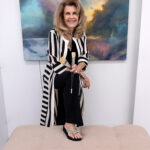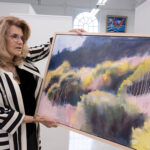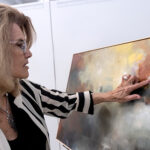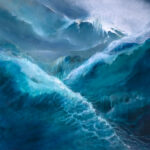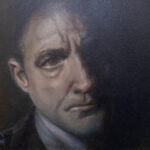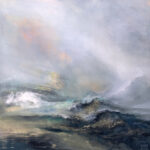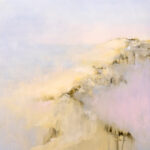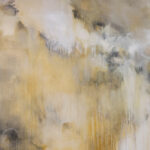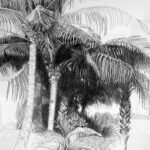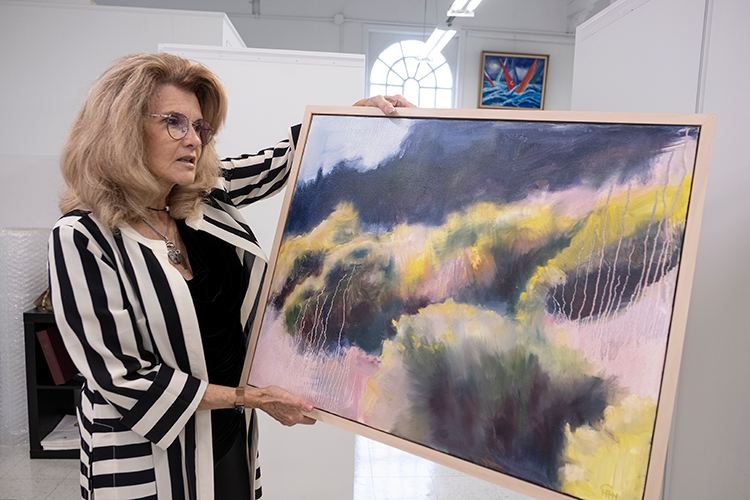
“I was always the class artist,” says Cathleen Hahn. As a young girl, Hahn says, she always had a pencil in her hand and “was very comfortable” drawing, even winning art competitions as a child.
Despite that early proclivity, Hahn didn’t begin to paint seriously and professionally until 2012, by which time she had moved to Hutchinson Island year-round (2008), having been a snowbird since the early 1990s.
Before that, Hahn had attended Pratt Institute in New York, majoring in interior architecture, before completing her education in Massachusetts with a degree in psychology.
“When I was at Pratt I had to move into painting. It was traumatic for me, and I was having nightmares,” says Hahn. She explains that she had been used to pencil drawing and was suddenly tasked with making broad strokes of varying colors. “That was a tough transition for me.”
Hahn combined her skills to create and run an advertising and graphic design business in Massachusetts for about 10 years before eventually moving back to her home state of New Jersey.
In 1992, after the dissolution of the USSR, Hahn moved to Kyiv and created the Gloria Ministries Crisis Center for Women, named after her Ukrainian mother. Collaborating with a doctor from Indiana, they also brought over a container of humanitarian aid for children and families. She returned to the U.S. in 1997 and taught fine art in local schools.
Like many artists, Hahn experimented with various mediums before deciding which to pursue. She decided against watercolors which, while lovely, she says are also fragile and don’t necessarily last as long. And, while acrylics were easy to work with, she found that the colors could change when the paint dried.
Eventually, Hahn chose oils, which she calls the Cadillac of paints. “It was a conscious decision for me and I’m not sorry I chose it; it’s wonderful.”
When Hahn began seriously painting, she shifted from realism into abstract painting, but muses that “it’s a continuum as well,” and that she often goes back and forth between the two.
“I have a low tolerance for boredom, and when I got tired of doing realistic work, which is a lot of hand-eye coordination, to relieve boredom I would switch to abstraction, which is much more difficult.”
Although she says realism can be an easier sell and was the norm here 25 to 30 years ago, she feels that the younger crowd moving in are looking for more contemporary work and the level of sophistication for art in Florida overall has grown.
“A lot of people think their 5-year-old grandchild can do abstract work. Anybody can throw paint on a canvas. But to actually make it appear to be something, not all abstract painters do that, but I do,” says Hahn.
“Almost everybody likes realistic work, because they look at it and say ‘oh, I could never do that,’ so they’re impressed by it. But from an artistic point of view, abstraction is much more difficult to get something that resonates, with the [viewer] as well as yourself, the painter, to find your thread. What appeals to you as a painter is a journey, which is unique for every painter.”
Hahn explains that with abstract painting, “it’s coming out of your mind, out of your emotion. You might have bits and pieces of an idea, like a sky scape, but you want to blur it, make it less realistic.”
Put in front of a canvas, Hahn says she is never sure what form the painting will take. “I have an idea, and I get excited about the idea, and then I start, and then the idea might not translate.”
But once she begins painting, she says the work starts to develop and come alive, “and then I go from there. Never trying to be too, too realistic, but always having that imaginary thread.”
In Hahn’s painting “Tumbledown,” she worked from a photograph, but took the unusual step of turning it upside down, so that it was less lifelike.
“That keeps you from painting too tightly,” she explains, adding that when it was almost done, she flipped the photo and the painting right-side up, and made a few adjustments. “I was pleased with the effect.”
Her early drawing skills have made her adept at tight, realistic portraitures, and she moderated the Vero Beach Art Club’s Life Draw class for a number of years. “I’m good at figurative paintings and portraits. That’s really easier for me than abstract.”
She has found that few people want to sit and hold the same expression or pose, but she prefers working live to working from a photo, explaining, “With the eye, you see much more color variation than you do with a camera.”
That doesn’t necessarily translate to plein air painting, which she used to do “between the fishermen” under the bridges. “I started out doing that every day, but decided to set up painting indoors, at home, in a controlled environment.”
When teaching beginning oils at the Vero Beach Art Club, she advises her students to evaluate their own work, find what works best for them, and then to just go for it.
Though some of her paintings sell quickly, Hahn admits that she likes to hold on to others for a while.
“The creative process is a delight sometimes, and the painting becomes special to me. Paintings are like children, and sometimes you want to keep them around just a bit longer before they are sent out into the world,” she explains.
In addition to teaching at the VBAC, where she says the Limited Palette, five-week course is a “pretty intense” course involving realism, landscape, and abstract, she has volunteered at the Juvenile Detention Center in Fort Pierce.
“Everybody has different gifting,” says Hahn, who hoped her words of encouragement might spark an interest in art down the road. “You just never know how much your words can mean to someone.”
Currently some of Hahn’s work can be viewed at the newly renovated VBAC Gallery (formerly known as the Annex), and she is hoping to find a commercially zoned studio where she can paint, teach, create, and evolve in her chosen craft.
Photos by Joshua Kodis

